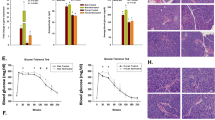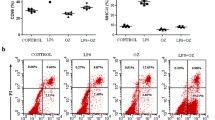Abstract
The genetic locus Idd6 is involved in type 1 diabetes development in the non-obese diabetic (NOD) mouse through its effect on the immune system and in particular, on T cell activities. Analysis of congenic strains for Idd6 has established the Aryl hydrocarbon receptor nuclear translocator-like 2 (Arntl2) as a likely candidate gene. In this study we investigate the role of Arntl2 in the autoimmune disease and T cell activation. An Arntl2 expressing plasmid was transfected into CD4+ T cells by nucleofection. Expression levels of cytokines and CD4+ T cell activation markers, cell death, apoptosis, and cell proliferation rates were characterized in ex vivo experiments whilst in vivo the transfected cells were transferred into NOD.SCID mice to monitor diabetes development. The results demonstrate that Arntl2 overexpression leads to inhibition of CD4+ T cell proliferation and decreases in their diabetogenic activity without influence on the expression levels of cytokines, CD4+ T cell activation markers, cell death, and apoptosis. Our findings suggest that Arntl2 at the Idd6 locus may act via the inhibition of CD4+ T cell proliferation and the reduction in the diabetogenic activity of CD4+ T cells to protect against autoimmune type 1 diabetes in the NOD mice.




Similar content being viewed by others
Abbreviations
- CFSE:
-
Carboxyfluorescein diacetate succinimidyl ester
- Arntl2:
-
Aryl hydrocarbon receptor nuclear translocator-like 2
References
Ando H, Takamura T, Matsuzawa-Nagata N, Shima KR, Eto T, Misu H, Shiramoto M, Tsuru T, Irie S, Fujimura A, Kaneko S (2009) Clock gene expression in peripheral leucocytes of patients with type 2 diabetes. Diabetologia 52:329–335
Bergman ML, Penha-Goncalves C, Lejon K, Holmberg D (2001) Low rate of proliferation in immature thymocytes of the non-obese diabetic mouse maps to the Idd6 diabetes susceptibility region. Diabetologia 44:1054–1061
Clements JL, Yang B, Ross-Barta SE, Eliason SL, Hrstka RF, Williamson RA, Koretzky GA (1998) Requirement for the leukocyte-specific adapter protein SLP-76 for normal T cell development. Science 281:416–419
Dere E, Boverhof DR, Burgoon LD, Zacharewski TR (2006) In vivo-in vitro toxicogenomic comparison of TCDD-elicited gene expression in Hepa1c1c7 mouse hepatoma cells and C57BL/6 hepatic tissue. BMC Genomics 7:80
Gunton JE, Kulkarni RN, Yim S, Okada T, Hawthorne WJ, Tseng YH, Roberson RS, Ricordi C, O'Connell PJ, Gonzalez FJ, Kahn CR (2005) Loss of ARNT/HIF1beta mediates altered gene expression and pancreatic-islet dysfunction in human type 2 diabetes. Cell 122:337–349
Hauben E, Gregori S, Draghici E, Migliavacca B, Olivieri S, Woisetschlager M, Roncarolo MG (2008) Activation of the aryl hydrocarbon receptor promotes allograft-specific tolerance through direct and dendritic cell-mediated effects on regulatory T cells. Blood 112:1214–1222
Hayashi M, Shimba S, Tezuka M (2007) Characterization of the molecular clock in mouse peritoneal macrophages. Biol Pharm Bull 30:621–626
Hung MS, Avner P, Rogner UC (2006) Identification of the transcription factor ARNTL2 as a candidate gene for the type 1 diabetes locus Idd6. Hum Mol Genet 15:2732–2742
Jones S (2004) An overview of the basic helix-loop-helix proteins. Genome Biol 5:226
Keppler OT, Tibroni N, Venzke S, Rauch S, Fackler OT (2006) Modulation of specific surface receptors and activation sensitization in primary resting CD4+ T lymphocytes by the Nef protein of HIV-1. J Leukoc Biol 79:616–627
Lai W, Chang CH, Farber DL (2003) Gene transfection and expression in resting and activated murine CD4 T cell subsets. J Immunol Methods 282:93–102
Li L, Iwamoto Y, Berezovskaya A, Boussiotis VA (2006) A pathway regulated by cell cycle inhibitor p27Kip1 and checkpoint inhibitor Smad3 is involved in the induction of T cell tolerance. Nat Immunol 7:1157–1165
Lyons AB, Doherty KV (2004) Flow cytometric analysis of cell division by dye dilution. Curr Protoc Cytom Chapter 9: Unit 9.11
Lyons AB, Hasbold J, Hodgkin PD (2001) Flow cytometric analysis of cell division history using dilution of carboxyfluorescein diacetate succinimidyl ester, a stably integrated fluorescent probe. Methods Cell Biol 63:375–398
Mantei A, Rutz S, Janke M, Kirchhoff D, Jung U, Patzel V, Vogel U, Rudel T, Andreou I, Weber M, Scheffold A (2008) siRNA stabilization prolongs gene knockdown in primary T lymphocytes. Eur J Immunol 38:2616–2625
Marshall NB, Vorachek WR, Steppan LB, Mourich DV, Kerkvliet NI (2008) Functional characterization and gene expression analysis of CD4+ CD25+ regulatory T cells generated in mice treated with 2, 3, 7, 8-tetrachlorodibenzo-p-dioxin. J Immunol 181:2382–2391
Molina TJ, Kishihara K, Siderovski DP, van Ewijk W, Narendran A, Timms E, Wakeham A, Paige CJ, Hartmann KU, Veillette A (1992) Profound block in thymocyte development in mice lacking p56lck. Nature 357:161–164
Nakayamada S, Saito K, Nakano K, Tanaka Y (2007) Activation signal transduction by beta1 integrin in T cells from patients with systemic lupus erythematosus. Arthritis Rheum 56:1559–1568
Quintana FJ, Basso AS, Iglesias AH, Korn T, Farez MF, Bettelli E, Caccamo M, Oukka M, Weiner HL (2008) Control of T(reg) and T(H)17 cell differentiation by the aryl hydrocarbon receptor. Nature 453:65–71
Rogner UC, Avner P (2003) Congenic mice: cutting tools for complex immune disorders. Nat Rev Immunol 3:243–252
Rogner UC, Boitard C, Morin J, Melanitou E, Avner P (2001) Three loci on mouse chromosome 6 influence onset and final incidence of type I diabetes in NOD.C3H congenic strains. Genomics 74:163–171
Rogner UC, Lepault F, Gagnerault MC, Vallois D, Morin J, Avner P, Boitard C (2006) The diabetes type 1 locus Idd6 modulates activity of CD4 + CD25+ regulatory T-cells. Diabetes 55:186–192
Rowley J, Monie A, Hung CF, Wu TC (2009) Expression of IL-15RA or an IL-15/IL-15RA fusion on CD8+ T cells modifies adoptively transferred T-cell function in cis. Eur J Immunol 39:491–506
Shi S, Hida A, McGuinness OP, Wasserman DH, Yamazaki S, Johnson CH (2010) Circadian clock gene Bmal1 is not essential; functional replacement with its paralog, Bmal2. Curr Biol 20:316–321
Tahvanainen J, Pykalainen M, Kallonen T, Lahteenmaki H, Rasool O, Lahesmaa R (2006) Enrichment of nucleofected primary human CD4+ T cells: a novel and efficient method for studying gene function and role in human primary T helper cell differentiation. J Immunol Methods 310:30–39
Tervo HM, Allespach I, Keppler OT (2008) High-level transfection of primary rabbit T lymphocytes. J Immunol Methods 336:85–89
Tisch R, McDevitt H (1996) Insulin-dependent diabetes mellitus. Cell 85:291–297
Vallois D, Grimm CH, Avner P, Boitard C, Rogner UC (2007) The type 1 diabetes locus Idd6 controls TLR1 expression. J Immunol 179:3896–3903
Veldhoen M, Hirota K, Westendorf AM, Buer J, Dumoutier L, Renauld JC, Stockinger B (2008) The aryl hydrocarbon receptor links TH17-cell-mediated autoimmunity to environmental toxins. Nature 453:106–109
Woon PY, Kaisaki PJ, Braganca J, Bihoreau MT, Levy JC, Farrall M, Gauguier D (2007) Aryl hydrocarbon receptor nuclear translocator-like (BMAL1) is associated with susceptibility to hypertension and type 2 diabetes. Proc Natl Acad Sci USA 104:14412–14417
Yeh CT, Lu SC, Tseng IC, Lai HY, Tsao ML, Huang SF, Liaw YF (2003) Antisense overexpression of BMAL2 enhances cell proliferation. Oncogene 22:5306–5314
Acknowledgements
We thank Joëlle Morin and Xiaoming Zhang for their excellent technical assistance. This work was supported by grants from the ANR (ANR-06-PHYSIO-016-01), the ARD, and the EFSD/JDRF/Novo Nordisk Programme and by recurrent funding from the CNRS, INSERM, and Institut Pasteur.
Author information
Authors and Affiliations
Corresponding author
Electronic supplementary materials
Below is the link to the electronic supplementary material.
Fig. S1
Arntl2 is without influence on the mRNA levels of cytokines IL-2, IL-4, IL-10, and IFN-γ in CD4+ T cells. a Q-RT-PCR assays showing that the expression levels of cytokines were comparable in splenic CD4+ T cells from NOD control mice and the congenic strain 6.VIII. Samples in each group were from six to eight females of 6–8 weeks of age. P > 0.05 for IL-2, IL-4, and IL-10; P = 0.03 for IFN-γ. b Arntl2 overexpression (24 h after transfection) in CD4+ T cells ex vivo failed to change the mRNA levels of the cytokines under non-stimulation conditions (n = 3; P > 0.05). (PDF 28 kb)
Fig. S2
Expression levels of cellular markers were similar in CD4+ T cells transfected with control plasmid and Arntl2 expressing plasmid (24 h after transfection). FACS histograms show the counts (Y-axis) and fluorescence intensities (X-axis) for anti-CD25, anti-CD62L, anti-CD44, anti-CD69, anti-GITR, anti-ICOS, and anti-TLR1 labeled cells. Culture control is the cell control that was not treated with the transfection process but only cultured in parallel. Transfection control is the cell control that was treated with the transfection process without adding plasmid. Gated events were between 15,000 and 25,000. (PDF 66 kb)
Rights and permissions
About this article
Cite this article
He, CX., Prevot, N., Boitard, C. et al. Inhibition of type 1 diabetes by upregulation of the circadian rhythm-related aryl hydrocarbon receptor nuclear translocator-like 2. Immunogenetics 62, 585–592 (2010). https://doi.org/10.1007/s00251-010-0467-7
Received:
Accepted:
Published:
Issue Date:
DOI: https://doi.org/10.1007/s00251-010-0467-7




